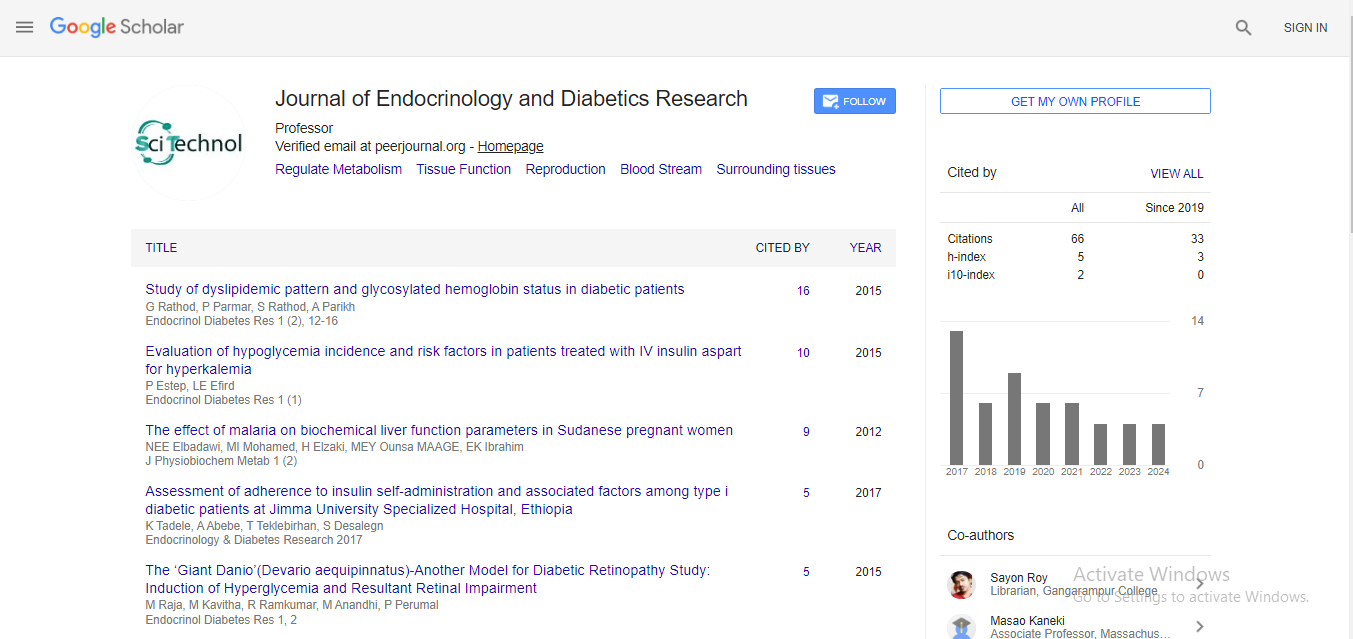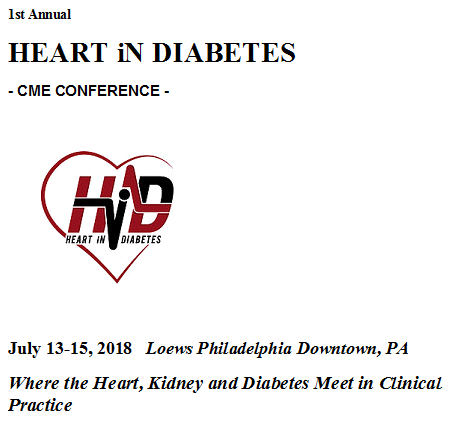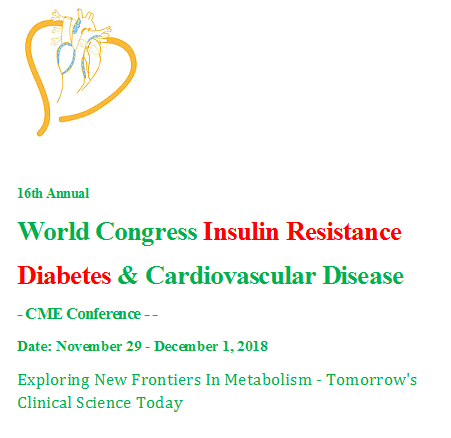Short Communication, Endocrinol Diabetes Res Vol: 10 Issue: 6
Hormonal Regulation of Insulin Sensitivity in Diabetes: Pathways and Potential Therapeutic Targets
Kim Dong*
1Department of Endocrinology and Metabolism, Kyoto Prefectural University of Medicine, Kyoto, Japan
*Corresponding Author: Kim Dong,
Department of Endocrinology and
Metabolism, Kyoto Prefectural University of Medicine, Kyoto, Japan
E-mail: Dongk7824922@163.com
Received date: 26 November, 2024, Manuscript No. ECDR-24-154186;
Editor assigned date: 28 Novemberr, 2024, PreQC No. ECDR-24-154186 (PQ);
Reviewed date: 12 December, 2024, QC No. ECDR-24-154186;
Revised date: 20 December, 2024, Manuscript No. ECDR-24-154186 (R);
Published date: 27 December, 2024, DOI: 10.4172/2324-8777.1000426.
Citation: Dong K (2024) Hormonal Regulation of Insulin Sensitivity in Diabetes: Pathways and Potential Therapeutic Targets. Endocrinol Diabetes Res 10:6.
Description
Diabetes mellitus is a complex metabolic disorder characterized by chronic hyperglycemia due to impaired insulin secretion, insulin action, or both. Hormones play a major role in regulating insulin sensitivity, influencing glucose homeostasis and metabolic pathways. This review focuses on key hormonal regulators of insulin sensitivity, their molecular mechanisms and potential therapeutic targets for diabetes management. By elucidating these pathways, we aim to highlight innovative approaches for improving insulin sensitivity and reducing diabetes progression.
Insulin sensitivity is a foundation of glucose metabolism, with its impairment being a mark of Type 2 Diabetes (T2D). Several hormones, including insulin, glucagon, adipokines and incretins, tightly regulate this process. Dysregulation of these hormones contributes to insulin resistance, resulting in hyperglycemia and associated complications. Understanding hormonal pathways and their interaction with insulin sensitivity provides insights into the pathogenesis of diabetes and identifies avenues for therapeutic interventions.
Insulin, secreted by pancreatic β-cells, promotes glucose uptake in peripheral tissues by activating the Insulin Receptor (IR) and with the current signalling pathways like PI3K-Akt and MAPK. Glucagon, released from cells, counteracts insulin by stimulating hepatic glucose production through glycogenolysis and gluconeogenesis. In diabetes, hyperglucagonemia magnify hyperglycemia by increasing hepatic glucose output. Therapies targeting glucagon signaling, such as glucagon receptor antagonists, aim to restore this balance and improve insulin sensitivity.
Adipose tissue acts as an endocrine organ, secreting adipokines like leptin, adiponectin and resistin that influence insulin sensitivity. Enhances insulin sensitivity by activating AMP-Activated Protein Kinase (AMPK) and PPAR pathways. Reduced levels in obesity and T2D correlate with insulin resistance. Strategies to upregulate adiponectin, including synthetic agonists, show promise in preclinical studies. Regulates appetite and energy expenditure but also modulates insulin sensitivity. Leptin resistance in obesity complicates its therapeutic use, though combination therapies may overcome this barrier. Promotes insulin resistance by interfering with IR signaling. Targeting resistin pathways may offer therapeutic potential for mitigating insulin resistance.
Incretins like Glucagon-Like Peptide-1 (GLP-1) and Glucose- Dependent Insulinotropic Polypeptide (GIP) enhance postprandial insulin secretion and suppress glucagon release. GLP-1 receptor agonists improve insulin sensitivity by reducing hepatic glucose output and promoting weight loss. Dual GIP/GLP-1 receptor agonists are emerging as potent agents for managing diabetes and obesity.
Cortisol, a glucocorticoid, increases hepatic gluconeogenesis and impairs glucose uptake in peripheral tissues. Chronic stress and hypercortisolism increase insulin resistance. Pharmacological agents targeting the Hypothalamic-Pituitary-Adrenal (HPA) axis or cortisol receptors may provide relief for stress-induced insulin resistance.
Gut hormones like Peptide YY (PYY), Cholecystokinin (CCK) and ghrelin influence glucose metabolism and appetite. Additionally the gut microbiota modulates hormonal secretion and insulin sensitivity through Short-Chain Fatty Acids (SCFAs) and bile acid signalling.
Interventions targeting the gut microbiome, such as probiotics, prebiotics and Fecal Microbiota Transplantation (FMT), have shown potential in improving insulin sensitivity by restoring hormonal balance and enhancing metabolic health.
Potential therapeutic targets
Development of agents that enhance adiponectin or GLP-1 activity while mitigating glucagon and resisting effects.
Combination therapies: Dual agonists for incretin hormones or co-administration of insulin-sensitizing agents with HRT or stress modulators.
Microbiome-based interventions: Utilizing gut hormones and microbiota to restore insulin sensitivity through dietary interventions or microbiome-targeted therapies.
Gene therapy: Precision medicine approaches to target genetic regulators of hormonal pathways impacting insulin sensitivity.
Conclusion
Hormones orchestrate a complex network regulating insulin sensitivity and glucose homeostasis. Dysregulation of these pathways contributes to the pathophysiology of diabetes. Advances in understanding hormonal regulation and identifying novel therapeutic targets hold the potential of innovative treatments to enhance insulin sensitivity, manage diabetes and improve patient outcomes. Future research must focus on integrating these insights into personalized medicine approaches for diabetes care.
References
- Kaneto H 2015 Pathophysiology of type 2 diabetes mellitus. Nihon rinsho. Japan jour of cli med. 73(12):2003-7.
- Kahn BB, Flier JS (2000) Obesity and insulin resistance. J Clin Invest, 106(4); 473-481.
- Saltiel AR, Kahn CR (2001) Insulin signaling and the regulation of glucose and lipid metabolism. Nature, 414(6865); 799-806.
- Rouiller DG, McKeon C, Taylor SI, Gorden P 1988 Hormonal regulation of insulin receptor gene expression. Hydrocortisone and insulin act by different mechanisms. J Biol Chem. 263(26):13185-90.
- Yki-Järvinen H (2005) Fat in the liver and insulin resistance. Ann Med, 37(5); 347-356.
- Hotamisligil GS (2006) Inflammation and metabolic disorders . Nature, 444(7121); 860-867.
- Kadowaki T, Yamauchi T (2005) Adiponectin and adiponectin receptors. Endocr Rev, 26(3); 439-451.
- Drucker DJ (2006) The biology of incretin hormones. Cell Metab, 3(3); 153-165.
- Biddinger SB, Kahn CR (2006) From mice to men: insights into the insulin resistance syndromes. Annu Rev Physiol, 68, 123-158.
- Schwartz MW, Seeley RJ, Zeltser LM (2017) Obesity pathogenesis: An endocrine society scientific statement. Endocr Rev, 38(4); 267-296.
 Spanish
Spanish  Chinese
Chinese  Russian
Russian  German
German  French
French  Japanese
Japanese  Portuguese
Portuguese  Hindi
Hindi 


